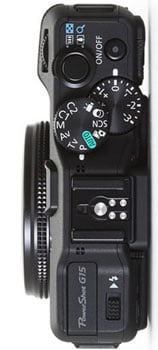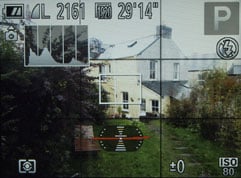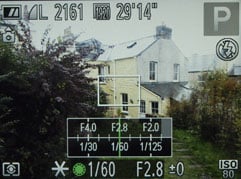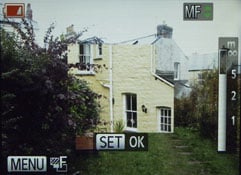Canon PowerShot G15 review
-
-
Written by Ken McMahon
Intro
The Canon PowerShot G15 is the latest model in Canon’s iconic G-series, originally launched back in 2000. Over the years these chunky compacts have become synonymous with no-nonsense design, fast lenses, and the kinds of physical controls and shooting modes, including RAW options, that enthusiasts are so keen on. But the changing nature of the digital camera market has prompted Canon to revise what many considered to be crucial features in and out of the G-range over the years, such as bright lenses, RAW shooting and articulated screens for example, an approach that has caused a certain amount of angst and frustration among loyal G-series followers.
The introduction of models like the G1 X and EOS M, not to mention the two year gap since the introduction of the G12 prompted some to speculate that we may have seen the end of the G series. But instead Canon has relaunched it in a guise that still fills a niche in the market for high end advanced compacts.
The G15 replaces the two year old G12 introducing a new 12.1 Megapixel CMOS sensor to replace the ageing 10 Megapixel CCD sensor of the G12. It has a new lens with the same 5x range as the G12, but its f1.8-2.8 maximum aperture is over a stop brighter throughout the range. Interestingly the G15 is a much slimmer, lighter, more compact camera than its predecessor, but much of the reduction in size has been achieved by, once again, abandoning the articulated screen. While the reaction to this from some will be ‘oh no, not again’, an equal number will be equally happy with the more compact lightweight format. Oh and in case you were wondering, there wasn’t a G13 or G14.
The new sensor and Digic 5 processor provide the G15 with improved video features including a best quality 1080p24 mode along with Canon’s super slow motion and miniature modes, plus the ability to encode in Apple’s edit-friendly i-Frame mode as well as the usual H.264.
Nikon’s Coolpix P7700 shares similar styling to the G15 and is endowed with even more physical controls; it also offers similar video modes, but that’s about as far as the similarities go. The Coolpix P7700 has a longer zoom range but its f2-4 lens isn’t as bright as the G15’s. Crucially, it has a fully articulated screen, but no optical viewfinder, it’s also bigger all round and heavier than than the G15. Read my full review to discover which of these two advanced compacts offers the best all round experience for those looking for DSLR-style features and handling in a smaller format.
 |
Canon PowerShot G15 design and controls
The Canon PowerShot G15 bears the trademark utilitarian, lightly retro styling of its predecessors in the PowerShot G series. It’s significantly smaller than the G12, largely due to the fact that the articulated 2.8in screen has been replaced with a slightly larger 3in one that’s fixed. That shaves 8mm off the camera’s depth and, though the Powershot G15 isn’t exactly what you’d describe as slim, it’s now a lot more pocket-friendly. The actual dimensions are 107x76x40mm and the weight with battery and card is 352g. Compare that with 112x76x48mm and a weight of 401g for the G12 and you can see that as well as a slimmer profile, the G15 loses about 5mm on its width compared with the G12.
The Nikon Coolpix P7700 has slightly bulkier, more rounded dimensions. It measures 119x73x50mm and weighs 392g with battery and card, it’s enough of a difference to make you think ‘pocket’ when you look at the PowerShot G15 and ‘carry case’ when you look at the P7700. One of the things that has a bearing on the size and weight difference is of course the P7700’s articulated screen, though on the other side of the balance sheet it lacks the G15’s optical viewfinder. Another small, but noteworthy, difference is that the PowerShot G15 has an integral lens cover where the P7700 has a push on cap.
 |
In terms of its styling and physical controls the G15 is actually a lot like a miniature version of the G1 X, sharing the same body shape and almost exactly the same physical control layout. The G1X, of course, derives much of its control layout from the G12. The top panel of both the G1X and G15 differ only in that the G15’s dual tiered control dials are offset with the exposure compensation dial (now sporting a broader range of +/-3EV), at the bottom extending to the rear and the mode dial on top flush with the front panel. This is actually a better arrangement from a handling perspective because you can operate the two dials independently with your index finger and thumb with your eye to the viewfinder. This arrangement has resulted in the loss of the G12’s ISO dial; the ISO is now adjusted via the control wheel on the rear, forcing the self-timer controls to the Func menu.
The flash is no longer always visible, but instead raises out of the upper left surface to provide greater clearance with the lens; unlike the neat motorised flash of the S100 though, the G15’s flash is manually popped-up by flicking a small switch. The Shortcut button in the upper left corner can be configured to present direct access to 15 settings, including custom white balance, drive mode and servo AF, along with switching between RAW and JPEG recording or enabling the built-in ND filter. Finally, a new dedicated red button is positioned in the top right corner to start recording video at any time.
In terms of connectivity the G15 features Mini USB and Mini HDMI ports along with a connector for the optional RS-60E3 cabled remote. Once again there’s sadly no microphone input, a missed opportunity which could have given it the edge over some CSCs. The hotshoe can however still accommodate Canon’s full range of Speedlite flashguns, although the built-in flash doesn’t have any wireless control, so you’ll need to employ an optional transmitter if you want to trigger any flashes off-camera. Note unlike the S100 there’s no built-in GPS, another missed opportunity; there’s no Wifi either.
 |
The G15 is powered by the same NB-10L Lithium Ion pack as used in the G1 X. Canon claims this is good for 350 shots with the screen or 770 with the optical viewfinder under CIPA conditions. Compare this to the more powerful NB-7L pack in the earlier G12 which was good for 370 or 1000 shots with or without the monitor. A downgrade, but not entirely surprising given the reduction in size and weight and the slightly larger screen. Finally, the WP-DC48 underwater housing allows you to take the G15 to depths of up to 40m.
As I’ve mentioned, the earlier G12’s built in flash which was located on the front panel, has been replaced in the G15 with a pop-up unit which is manually activated by sliding a small switch on the top panel just behind it. The extra height above the lens should help reduce the chances of red-eye and lens shadow when shooting close subjects. The flash has a quoted range of 7 metres at the wide angle lens setting and has On, Off, Auto and Slow Synchro modes. Flash exposure compensation of up to plus or minus two stops can be set and the power can be adjusted manually to one of three levels. There’s also the option of 1st or 2nd curtain sync.
The G15 retains its standard hotshoe, which can be used to mount an external Speedlite flash. With the 220EX, 270EX, 430EX II or 580EX II mounted, the flash control menu switches to external control, offering similar options to Canon’s DSLRs. These allow you to again adjust flash compensation (with a broader +/-3EV range), set rear curtain and slow sync options along with red-eye correction and wireless control.
Canon PowerShot G15 screen and Viewfinder
The PowerShot G15 is fitted with a fixed 3 inch LCD TFT screen with a 922k dots. This will no doubt be something of a disappointment to long-time G Series fans, not to mention a bit of a deja vu moment. Early G series PowerShots all had flip out screens, but Canon reverted to fixed screens from the G7 onwards, only to go back to them for the G11 and G12. Whether you’re a fan of the flip out screen or not, there’s no arguing with the fact that by fitting a fixed screen Canon has been able to make the G15 much smaller and more portable. If an articulated screen is a non-negotiable feature, the Nikon Coolpix P7700 can oblige or if you’re too much of a G series loyalist to look elsewhere there is of course the more expensive G1 X. Both of these models are bigger and heavier than the G15 though.
On the upside though, the G15’s panel is larger and more detailed than its predecessor, and provides a warm bright and contrasty image with a good wide viewing angle. You can control the brightness from the menu, but that won’t help in bright sunshine where, like most screens the G15’s struggles, but at least you’ve got the optical viewfinder to fall back on in such situations.
An optical viewfinder has been a feature of G Series PowerShots since the introduction of the G1 in September 2000. It’s useful as an alternative means of composition, but with no proximity detectors, you need to manually switch off the screen to prevent it from distracting you during composition.
The G15’s optical viewfinder is very small and is prone to all the usual problems associated with non-through-the-lens viewing systems. There can be parallax errors, you can see the lens in the corner of the viewfinder at wide angle settings, there are no superimposed guides and the coverage is less than 100 percent. Added to which you can’t tell where the camera has focussed (though the audible beep and green light tell you that it has) or see exposure or other information.
On the plus side, the optical viewfinder can be corrected for spectacle wearers, it’s more visible than the screen in bright conditions, it’s possible to hold the camera more stably when it’s held to your eye, and as an optical viewfinder, it’ll greatly extend the battery life. As stated above, you’re looking at 350 shots with the screen versus 770 with the viewfinder. Another benefit is it doesn’t black out while shooting, which means you can more easily follow action with the viewfinder. That said, there’ll be those who’ll wish Canon fitted the G15 with an electronic viewfinder, and others who’d prefer there was none at all for an ultimately smaller and lighter body; in Canon’s world, the latter will be steered towards the S110.
Canon PowerShot G15 lens and stabilisation
The PowerShot G15 has a 5x optical zoom with a range of 6.1 to 30.5mm, 28mm to 140mm in 35mm equivalent terms. That’s the same range as the earlier G12, but the f1.8 – 2.8 lens is more than a stop brighter across the entire zoom range. Early G series PowerShots were renowned for their bright lenses and this return to the old form wasn’t a matter of choice for Canon in a market where big sensors and bright lenses have become almost commonplace. The G15 is arguably competing with the Lumix LX7 (f1.4-2.3), the Sony RX100 (f1.8-4.9), the the Olympus XZ-2 iHS (f1.8-2.5) as well as Canon’s own S110 (f2-5.9) and G1 X (f2.8-5.8). For the sake of completeness I should mention here that the Nikon Coolpix P7700 is equipped with a 28-200mm equivalent f2-4 zoom.
The advantage of this bright aperture is twofold. Obviously it makes the G15 a much more capable low light performer. Effectively you’re able to shoot at the 200 ISO setting with the G15 in situations where you’d need to be using 500 ISO on the G12. Alternatively you’re able to shoot with a faster shutter speed on the G15.
Canon PowerShot G15 coverage wide |
Canon PowerShot G15 coverage tele | |
 |  | |
| 6.1-30.5mm at 6.1mm (28mm equiv) | 6.1-30.5mm at 30.5mm (140mm equiv) |
The other advantage of a wide maximum aperture combined with a larger sensor than a typical point-and-shoot camera is that it unlocks the potential for shots with a shallow depth of field. The G15’s 1/1.7in sensor may be only a little larger than the typical 1/2.3in compact sensor size, but that doesn’t mean you can’t produce shallow depth of field. Depth of field reduces at longer focal lengths and the closer you get to the subject – at it’s maximum 140mm equivalent focal length the G15 still maintains a relatively wide f4 aperture. The Panasonic Lumix LX7 has shown that shallow depth of field is achievable in compact with a sensor this size, beating the performance of the G1 X with its much larger almost APS-C sized sensor because it is able to focus closer.
To compare the depth of field performance of the PowerShot G15 and the Coolpix P7700 I set them both to their maximum telephoto focal lengths, 140mm on the G15 and 200mm on the P7700, and got as close to the subject, the leaf in the images below, as possible while still being able to focus. Both of these cameras allow you to get quite close to subjects even when zoomed in, but you can get closer with the G15 at its 140mm equivalent maximum zoom than you can with the 200mm of the Nikon P7700. The G15 also has a brighter f2.8 maximum aperture when zoomed in than the f4 of the P7700. Both cameras produce quite shallow depth of field in the images below and there’s not much to choose between them, but with its brighter lens I say the G15 has a slight edge here.
Canon PowerShot G15 and Nikon P7700 macro depth of field | ||||
 | .jpg) | |||
PowerShot G15 6.1-30.5mm at 30.5mm (140mm equiv.) 80 ISO f2.8 | Coolpix P7700 6-42.8mm at 42.8mm (200mm equiv.) 100 ISO F4 | |||
For my second test I shot these two portraits at a more typical portrait distance for a head and shoulders shot. This time I set both cameras to roughly equivalent focal legths – the maximum 140mm equivalent on the G15 and chose the widest available aperture in Aperture Priority mode – f2.8 on the G15 and f3.5 on the P7700. Both cameras have thrown the background slightly out of focus, though not by nearly as much as you’d be able to on a DSLR or CSC with an APS C sensor and an equivalent lens aperture. Again, the PowerShot G15 edges it with a slightly more blurred background than the Coolpix P7700.
Canon PowerShot G15 and Nikon P7700 portrait depth of field | ||||
 |  | |||
PowerShot G15 6.1-30.5mm at 30.5mm (140mm equiv.) 200 ISO f2.8 | Coolpix P7700 6-42.8mm at 28.4mm (135mm equiv.) 200 ISO F3.5 | |||
The PowerShot G15’s lens has optical image stabilisation that Canon claims allows hand held shots to be taken using shutter speeds four stops slower than would otherwise be possible. To test it I zoomed the G15 to its maximum telephoto focal length of 140mm equivalent and took a series of handheld shots in Shutter priority mode at progressively slower speeds.
As you can see from the crops below, I managed to get a clean shot with no camera shake from the G15 at 1/5, which is close to five stops slower than conventional wisdom says is advisable at this focal length. To be fair, the G15’s size, shape and weight make it possible to shoot unstabilised at speeds slower than the 1/140 that the photographers rule of thumb suggests at this focal length, but this is an impressive performance nonetheless.
Canon PowerShot G15 Image Stabilisation Off/On | ||||
 |  | |||
100% crop, 6.1-30.5mm at 30.5mm 200 ISO 1/5th IS Off. | 100% crop, 6.1-30.5mm at 30.5mm 200 ISO 1/5th IS On. | |||
Canon PowerShot G15 shooting modes
Set the G15 to Aperture Priority and you can choose from f2.0 to f8 (when fully zoomed-out). Set it to Shutter Priority and you can access speeds from 1/4000 to 15 seconds with no restrictions and an impressive maximum flash sync speed of 1/2000.
Exposure compensation is available in a range of +/-3EV in 0.3EV steps using the upper dial, while three-frame exposure bracketing is offered in a range of +/2 EV, again adjustable in 0.3 EV increments. By default, the G15’s front finger dial is used to adjust the aperture and shutter speed in these respective modes. Switch the G15 to Manual and the finger dial controls the shutter, while the rear wheel adjusts the aperture. It’s all very intuitive, although anyone wanting to shift the Program combination with a simple spin of the wheel will need to remember to press the AE Lock button first.
Aperture Priority does allow you to select the optimum f-number to avoid diffraction. Shutter Priority also lets you choose deliberately slower-than-normal exposures to blur moving action, such as waterfalls or racing vehicles. You can find out how to achieve these effects in my Blurring Action tutorial and Photographing Water tutorial. Meanwhile, full Manual lets you choose combinations of aperture and shutter which go way beyond normal metering or compensation ranges, allowing you to achieve massive under or over-exposures. You can also choose long exposures up to 15 seconds with ease.
At the other end of the scale is the G15’s Auto mode, which employs scene detection in an attempt to identify what you’re pointing the camera at. The PowerShot G15 doesn’t just recognise people or close-up shots, but also the lighting conditions for each, differentiating between bright conditions, blue skies, spot-lit or night-time, and whether the subject is backlit or not; the G15 can also detect whether the person is in motion or has strong facial shadows. In each instance, the exposure and flash are adjusted accordingly, and the camera will even attempt to recognise a Sunset and boost the colours. All of this is handled by the Digic 5 processor with more sophisticated scene detection producing better results in a wider range of conditions than the earlier G12 with its Digic 4 processor.
In Auto the G15 can also choose from six different stabilisation options: still, panning, macro, dynamic and power (when filming), or switched off when the camera detects it’s mounted on a tripod or somewhere steady. The actual conditions or subject recognised by the camera is indicated by an icon in the top left corner, which you’ll see adjust as you recompose. You’ll need to check the manual to confirm what each icon means though, for example those taken under normal, blue or dark skies feature grey, blue or dark blue icons respectively, while backlit situations have a Sun in the corner.
Or rather than learning the icons and second-guessing the camera, you could simply relax and trust the G15 as like other recent Canon compacts it does a pretty good job of recognising the scene and choosing the best settings for it. In practice, the camera seamlessly switches between portrait mode with face detection when pointed at a person, or into macro mode when placed close(ish) to a subject.
If you like the automatic life, but prefer a little extra control, turn the mode dial to SCN to access 10 presets. Like other recent Canon compacts, the G15 uses the SCN position to house an eclectic range of other shooting modes including Movie Digest, High-speed Burst, Handheld Nightscene, and panoramic-stitch assistance. Strangely the SCN mode is also where you’ll find the Smart Shutter options which trigger the shutter after detecting a new face, a smile or a wink. Surely it would be more sensible to find these in the self-time or drive section?
Making more sense is the Creative Filters Mode position on the dial which offers HDR, Nostalgic, Fisheye, Miniature, Toy Camera, Soft Focus, Monochrome, Super Vivid, Poster, and Canon’s Colour Accent and Colour Swap modes. Like the G12 before it, the HDR mode automatically combines three exposures to extend the tonal range, but there’s no control or even indication of the bracketing range or tone map technique.
Here’s some examples of the filters in action, starting with effects using their default settings; it’s possible to vary the strength of the fisheye distortion along with adding sepia or blue tints in the Black and white mode
 |
 |
 |
| HDR | Nostalgic | Fish-eye Effect |
 |
 |
 |
| Toy Camera Effect | Super Vivid | Poster Effect |
Canon PowerShot G15 movie modes
In an big upgrade over the earlier G12 which only offered a 720p best quality video mode, the G15 , like the G1 X and S110 supports full HD 1080p video. The G15 gives you the choice of 1080/24p, 720/30p or 640×480/30p, along with an optional Miniature effect, Canon’s Movie Digest compilation at VGA and the iFrame-friendly 720/30p mode. The G15 also includes Canon’s Super Slow Motion movie mode which offers two recording speeds, 640 x 480 at 120fps and 320 x 240 at 240fps, providing playback speeds of 1/4 and 1/8 real time speed respectively. Below is a a short clip showing the Miniature mode effect on a movie. As with other Canon Compacts, you can record miniature mode movies in 640×480 or 1280×720 resolution. The example below was shot in 640×480 mode, recording for one minute at the 5x speed (there are also 10x and 20x options) resulting in a 12 second clip.
| |
|---|---|
|
Unlike the PowerShot G12, you can zoom the G15’s lens while filming and the camera will also attempt to continuously autofocus while recording. What you won’t get are the choice of frame rates of Canon’s DSLRs and there’s also no manual exposure control when filming, beyond exposure lock or compensation. The maximum recording time is a second shy of half an hour or when the file reaches 4GB, which for the G15 in 1080p and 720p modes will be after about 14 and 20 minutes respectively; Canon recommends using a Class 6 SD card or quicker.
Audio is recorded by built-in stereo microphones, but sadly there’s no external microphone input, as on the G1 X, a missed opportunity as both are equipped with a standard hotshoe which would have been ideal for mounting external microphones. Now let’s have a look at a selection of clips to demonstrate its capabilities, all filmed in the best quality 1080/24p mode unless otherwise stated.
| |
|---|---|
|
This and all of the video samples here were shot using the PowerShot G15’s 1080p24 mode. It’s hard to fault the G15 here, although the light conditions aren’t particulalry demanding, the exposure is good, the stabilisation does a good job and the focus is accurate and unobtrusive. The built in stereo microphones do a good job with the audio and you can’t hear the AF or zoom motors at work.
| |
|---|---|
|
For this tripod mounted panning shot the stabilisation was disabled. It’s another great performance from the G15, this time in more demanding lighting conditions. There’s a little bit of flare when facing directly into the sun, but that’s only to be expected. The auto exposure copes very well with the brightness changes and there’s none of the streaking that you’d get with the G12’s CCD sensor. Again, the AF is rock steady and the zoom motor is inaudible.
| |
|---|---|
|
The quality on this low-light interior panning shot is very pleasing with little evidence of noise. For the first time the G15’s AF shows a little hesitation with some hunting back and forth at the beginning of this clip. The automatic exposure control is good, but the white balance is a little wayward at the end.
| |
|---|---|
|
My coffee cup example here shows the effectiveness of the G15’s Contunuous AF. With the lens zoomed in a little the focus is initially on the coffee cup and, as the camera pans up to bar shifts to focus on the bottles and glasses. Then it’s a pan back down to the cup and finally back up to the bar a final time. On the pan up to the bar, the G15 responds so quickly and smoothly you hardly notice it’s happening, in the reverse direction it takes a second to refocus on the cap, but when it does so it happens reasonably quickly. An impressive performance.
Canon PowerShot G15
handling
Personally, I like the more compact dimensions of the G15 and the fact that you can easily slip it into a coat pocket. In my view, the loss of the articulated screen is a reasonable trade off, but if you shoot a lot of video or yourself, or like to shoot from low or high angles you may not feel the same way. The G15 is ready to shoot in about one and a half seconds after you switch it on. It has a compact-style integral lens cover that automatically opens when you turn it on which is preferable to an external lens cap like that found on the Nikon Coolpix P7700, but again that’s a personal view.
One of the features of the G series that makes it so attractive to enthusiasts is the abundance of physical controls and the twin dial layout, which allows you to change shooting modes with your index finger and adjust exposure compensation with your thumb, works a treat. But many, myself included, will mourn the loss of the G12’s dedicated ISO dial. While ISO settings are still very accessible using the top position on the rear wheel, having all three exposure controls – aperture, shutter speed and ISO – on physical dials provides the ultimate control.
When shooting, the screen offers the choice of two display overlays, or you can turn it off altogether if using the optical viewfinder. It would be far better if Canon had fitted the G15 with a proximity sensor so that this happened automatically, a missed opportunity that would have made a big difference to the handling. The basic display includes quite a lot of information including Exposure mode, battery level, remaining exposures / movie recording time, ISO level and metering mode. And when the shutter is half pressed exposure info is added. As well as numerical readouts of the aperture and shutter speed, in modes where they can be adjusted they are displayed in a scale. This, along with a small icon indicating which dial to use, makes the whole business of manual and semi automatic exposure control really straightforward.
Pressing the down position on the rear control wheel toggles to the second display overlay which adds a live histogram, square grid and a two-axis electronic level – upgraded from the single axis display on the G12 (and the G1 X). All of this is great, but it would be even better if Canon had provided some way of cycling though these two display options without having to go through the display off mode. As it is, if you want to use the histogram, grid, or level, after activating it, you must press down twice on the control wheel to first turn off the display, then get back to the first overlay. While you can customise or de-activate any of the overlays, this isn’t really a solution if you want to toggle between the overlays on some occasions and turn the display off on others. And it’s another argument for including a proximity sensor.
 |
 |
 |
 |
 |
 |
 |
 |
 |
The G15 shares the same menu setup a other models in the PowerShot range. Essentially, this consists of tabs for shooting and camera settings with the G15 adding a My menu tab to which you can add up to five favourite or most commonly used menu settings. But the most often used shooting functions are to be found on the FUNC menu, accessed by pressing the centre button on the control dial. These are arranged down the left side of the screen with options for the selected setting displayed across the bottom. From here you can quickly select white balance, bracketing, drive modes, self-timers, the built-in ND filter as well as quality settings for still images and movies.
The PowerShot G15 provides ample options for customisation. Two positions on the mode dial, C1 and C2, allow you to save an entire shooting settings configuration including shooting mode, metering mode, exposure compensation, ISO setting, bracketing and even zoom position and manual focus positions. The shortcut button at the top left of the rear panel can be allocated to one of fifteen settings including custom white balance, drive mode, self-timer, the ND filter and AF lock. Finally, you can also assign custom functions to the front and rear control dials.
Canon PowerShot G15 Autofocus
The PowerShot G15 inherits the same three auto-focusing modes of the G12, S110 and G1 X: FlexiZone, Face AiAF and Tracking AF. As before, FlexiZone focuses on a single area, the position of which can be adjusted to almost anywhere on the screen; you can also choose from two different sizes for the AF area. The Face AiAF mode automatically employs face detection if a person is recognised in the frame, or switches to a traditional nine-area system in the absence of a suitable face. In my tests this worked quickly and seamlessly, and like other recent Canon compacts, the G15 tracks human faces with great success. If you’d like to check the focus before taking the shot, the G15 offers AF-Point Zoom, which enlarges either the selected AF area or the primary face when you half-press the shutter. Alternatively you can set the camera to display an enlarged view of the focusing area after taking the photo.
The Tracking AF option displays cross-hairs in the middle of the screen which should be placed over the subject you want to track. Then after pressing the AF area button, the camera will attempt to follow the desired subject. The G15 automatically enables Servo AF in Tracking AF mode, allowing it to continuously adjust the autofocus until the point of capture. In use this worked pretty well, managing to track a variety of non-human subjects and keeping them in focus, so long as they were within the focusing range of course.
The G15 additionally offers Blink Detection, which as its name suggests, can spot when a subject has blinked at the moment the photo was captured. This works in practice, briefly displaying a blinking face icon in the corner of the screen as a warning immediately after taking the photo. It will however only work if the subject in question has already been acquired by the face detection system. Blink detection is also exploited in the Face Timer mode. The autofocusing on the PowerShot G15 feels fairly responsive and generally locks-onto a subject in less than a second, although it’s not as snappy as the quickest CSCs like the Oympus PEN E-PL5.
Pushing the rear control wheel to the left allows you to select macro or manual focus mode. For manual focus you can use the thumb wheel to adjust the focusing distance in many fine increments, indicated by an on-screen scale. The middle portion is magnified during manual focus, even so it’s still quite difficult to determine if a subject is sharp unless it’s within a few metres of the camera, making this an option really only suitable for static subjects close up. If you’d like a little extra help, the G15’s Safety MF option lets you get the focusing close by hand, then finishes it off automatically at a half-press of the shutter release. Alternatively you can opt for the focus bracketing mode which takes three shots: one at the manually focused distance, and the others a little closer and further. The nearer and further increments can be set to small, medium and large.
Canon PowerShot G15 Continuous shooting
The Canon G15 may sport a slightly bigger sensor than point-and-shot compacts, but its continuous shooting performance is little better than a standard point-and-shoot, and worse, a standard point-and-shoot from Canon, which has a reputation for unremarkable burst speeds. Continuing this poor tradition, the main continuous shooting mode on the G15 fires at a disappointingly slow rate of 2.1fps without AF, falling to an almost offensive 0.9fps if you’d like autofocus or live view between shots. Yes, that’s comfortably less than one frame per second and G15 owners will take little consolation from the fact that this is marginally better than the continuous shooting performance of the G1 X which of course has a much larger sensor.
Offering some consolation is the High-speed Burst HQ mode which increases the rate to 10fps, for a ten shot burst, thereby grabbing one second of action. To put the numbers to the test I fitted a freshly formatted 8GB SanDisk Extreme Pro UHS-1 card, set the shutter speed to 1/500 and started timing. With the G15 set to its normal continuous shooting mode without AF, it seemed happy to keep taking photos while the shutter release button was held down. I fired-off 50 Large Fine JPEGs in 26.8 seconds, which corresponds to a rate of 1.86fps, slightly slower than quoted. In High-speed Burst HQ mode, the G15 captured ten frames in exactly one second, corresponding to the quoted 10fps speed.
Canon PowerShot G15 Sensor
The PowerShot G15 has a 12 Megapixel CMOS sensor coupled with the Digic 5 processor, an update to the 10 Megapixel CCD sensor and Digic 4 combination in the Earlier G12. The physical size of the sensor remains at 1/1.7in -the same size and in fact the same sensor as in the PowerShot S110. The 1/1.7in sensor is slightly larger than the 1/2.3in sensor found in standard point and shoot compacts. The Nikon P7700’s sensor shares a sensor of the same size.
The PowerShot G15’s ISO sensitivity ranges from 80 to 12,800 ISO and its shutter speed range is 15 to 1/4000. It saves files in JPEG format at a choice of two compression settings. The best quality Superfine JPEGS are between 5 and 6MB in size.
To see how the quality of the PowerShot G15 measures-up in practice, take a look at my Canon G15 quality and Canon G15 noise results pages, browse my Canon g15 sample images, or skip to the chase and head straight for my verdict.
 Despite shortcomings the G15 is a compact and capable performer which will continue to attract those looking for a sturdy compact with a larger sensor, bright lens, and plenty of physical controls. It's a fun camera to use and is without doubt the best G Series Powershot to date, earning a Cameralabs Recommended award. The design and feature-set also makes sense in Canon's overall line-up, successfully slotting between the S110 (aimed at those who want a smaller camera with similar quality and control), and the G1 X (aimed at those willing to accept a bigger body in return for a larger sensor and DSLR quality).
Despite shortcomings the G15 is a compact and capable performer which will continue to attract those looking for a sturdy compact with a larger sensor, bright lens, and plenty of physical controls. It's a fun camera to use and is without doubt the best G Series Powershot to date, earning a Cameralabs Recommended award. The design and feature-set also makes sense in Canon's overall line-up, successfully slotting between the S110 (aimed at those who want a smaller camera with similar quality and control), and the G1 X (aimed at those willing to accept a bigger body in return for a larger sensor and DSLR quality).



